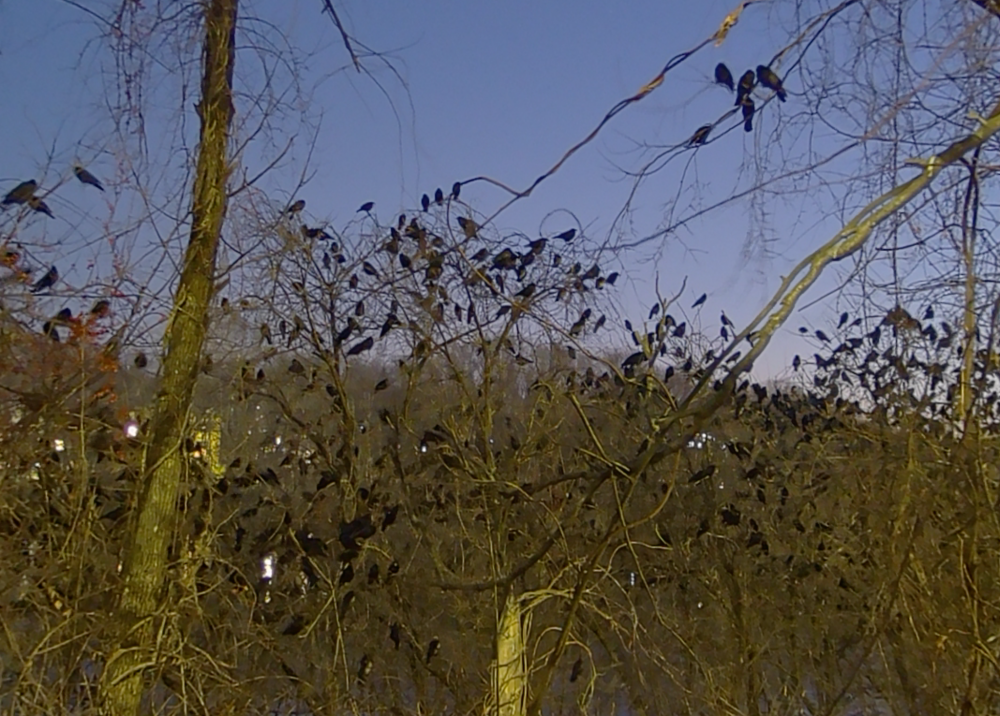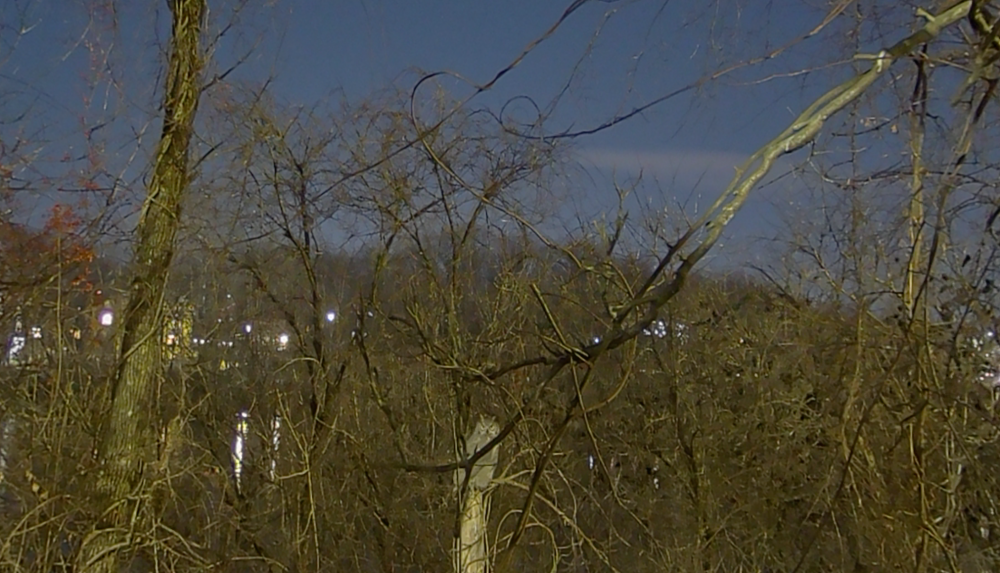Great Horned Owl lands in middle of overnight crow roost!
During a Crow Patrol outing on Sat. Dec. 11, we placed a small time lapse camera in the tree in the back section of the overnight crow roost. The camera was set up facing south with views of the roost, the Merrimack River below, the tress along the south shore of the river, northbound traffic coming over the Rt. 495 Bridge, and some sky line. It was a clear night with light winds. The camera was meant to capture time lapse scenes each night, for 90 minutes, from just before sunset until after the Crows were well settled into the roost. This image below, shows a view of the what had been the intended scene, showing a section of the overnight roost, which would fill up with Crows as the roost got started each night.

What a surprise to start reviewing the collected time lapse footage and discover this amazing visit by a Great Horned Owl. In the past, I’ve read a wide mix of written accounts, all about possible reasons for Crows forming these large roosts, and always mention is made about the Crows avoiding nocturnal predators, especially Great Horned Owls. For all of the mentions, it was always interesting that there had been little evidence to actually support the Great Horned Owl visits. Nonetheless, here is the Great Horned Owl, balanced on a tree snag, right in front of the camera, after dark has settled in, and in the midst of a visit to the roost. Some of the Crows, visible on distant branches off to the right, remain in place.

Thought it might be fun to share comments made by others, from online sources, about Great Horned Owls and Crow roosts:
“Because great horned owls go into crow roosts at night to take crows for food, we often see bands of American crows chasing and generally harassing owls in the daytime. I have witnessed this several times. The voices of the crows carry the hysterical fear of their nights over into the day. They know it’s possible that owls will come to the crow roost and repeat the ritual.”
In addition to warmth, roosting in populated areas like cities and suburbs may provide some protection from nocturnal predators, especially owls. “Owls are the biggest predators for crows,” Robinson says. “Especially the great horned owl.”
Jacqueline Dooley; Poughkeepsie’s Massive Crow Roost https://www.scenichudson.org/viewfinder/poughkeepsies-massive-crow-roost/
Protection from predators may be a major factor in this behavior, according to ornithologists. The more crows there are together, the more likely it is some of the birds will see a predator coming and cry out the alarm.“If there are thousands of you, you’re less likely to get picked off by a great horned owl,” said Jay Kaplan, executive director of the Roaring Brook Nature Center in Canton. Kaplan is also one of the leaders of the Hartford area Christmas Bird Count for the National Audubon Society, a group that has been observing the Hartford roost for more than a decade.
Gregory B. Hladky; Hartford Courant, Jan. 12, 2021 https://www.courant.com/news/connecticut/hc-news-ct-crow-roosts-20200113-xquequrpkjhnlhreaclflztzee-story.html
But Doug says the crows aren’t gathering for any nefarious reason. They do it, scientists believe, to stave off predators like the Great Horned Owl, stay warm, look for mates and possibly share some news.
Susan Sharon; Birds of a Feather, Maine Public, Mar 7, 2019 https://www.mainepublic.org/environment-and-outdoors/2019-03-07/birds-of-a-feather-why-crows-congregate-in-winter
Dr. Kevin McGowan; Frequently Asked Questions About Crow, Cornell Lab of Ornithology https://www.birds.cornell.edu/crows/crowfaq.htm
Biologists hypothesize that cities were safe havens from hunting and from crow predators, such as Great Horned Owls and large hawks, but also a source of year-round, dependable, if dubiously nutritious food. Our street lights may also play a role. In the winter, owls at night are the main danger, besides weather and hunters outside city limits. Like most diurnal birds, crows cannot see well in the dark; by roosting near lights in cities, crows may be able to see and flee these nocturnal predators.
Anne Clark; Binghamton University behavioral ecologist; crowroost.com website http://crowroosts.org/crowroosts-about/
Why do the crows congregate to spend the night together? We don’t have a definitive answer but some intriguing suggestions have been proposed. Aside from humans with guns, the major threat to American Crows is predation by Great Horned Owls. Perhaps you have seen American Crows mob a roosting Great Horned Owl during the day. The crows are brutal, swooping down on the owl and pecking it. Usually the owl is forced to fly to find a more peaceful place to sleep. Roosting might therefore offer protection from owl predation. It is awfully hard for an owl to approach when a thousand or more crows are keeping a vigilant watch.
Wilson, W. Herbert,, Jr. Leslie Brainerd Arey Professor of Biosciences Emeritus (Retired) https://web.colby.edu/mainebirds/2012/04/02/crow-roosts/
Note on counts/estimates: we are now using much improved methods for counting the large number of Crows while streaming, staging, and in the roost. For all images, we use both a modified open source software program, as well as a hand count approach to carefully document our observations and to increase reliability and accuracy of the presented numbers.
THE 2021 NATIONAL AUDUBON CHRISTMAS BIRD COUNT (CBC) ESTIMATE FOR THIS CROW ROOST: 12,250
Check out the newly launched Crow Patrol Podcast: wintercrowroost.com/podcast/
Photo gear used for this outing:
Afidus ATL-200 (long term time lapse camera)
Follow us on Instagram: wintercrowroost
Follow us on YouTube: birdsoftheair1
Blog post and photos by Craig Gibson, 2021 Crow Patrol
Additional text here.


Leave A Comment